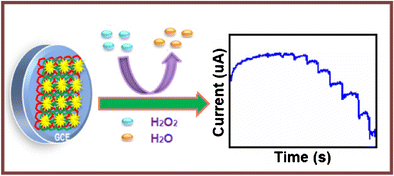
|
|||||
|
|
Non-enzymatic sensing of hydrogen peroxide using a glassy carbon electrode modified with the layered MoS |
|
| Authors: | Zhenyu?Cheng,Qihui?Shen,Huashi?Yu,Dandan?Han,Fangli?Zhong,Yingjie?Yang mailto:chengzy@.com" title=" chengzy@.com" itemprop=" email" data-track=" click" data-track-action=" Email author" data-track-label=" " >Email author |
| Affiliation: | 1.College of Chemistry and Pharmaceutical Engineering,Jilin Institute of Chemical Technology,Jilin,China |
| Abstract: | The authors describe an electrochemical sensor for hydrogen peroxide (H2O2). It was constructed by consecutive, selective modification of a glassy carbon electrode (GCE) with Prussian Blue (PB), layered molybdenum disulfide (MoS2), and reduced graphene oxide (rGO). The properties of the modified GCE were characterized via high-resolution transmission electron microscopy, UV-vis spectroscopy and X-ray diffraction. The electrochemical properties of the electrode were studied using cyclic voltammetry and electrochemical impedance spectroscopy. The sensor exhibits excellent electrocatalytic activity for the reduction of hydrogen peroxide in comparison to GCEs modified with MoS2-rGO or PB only. Response is linear in the 0.3 μM to 1.15 mM H2O2 concentration range at a working analytical voltage of 0.1 V, with a 0.14 μM detection limit. The electrochemical sensitivity is 2883.5 μA·μM?1·cm?2, and response is fast (<10 s). The sensor is selective, stable and reproducible. This is attributed to the efficient electron transport properties of the MoS2-rGO composite and the high loading with PB. Graphic abstract Prussian Blue nanoparticles were deposited on MoS2-rGO modified glassy carbon electrode by electrochemical method. This sensor was used for the detection of H2O2 in tap water and river water. |
| Keywords: | |
| 本文献已被 SpringerLink 等数据库收录! | |
